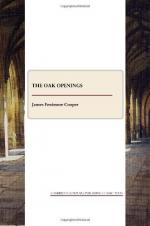Although there was probably no intention on the part of the captors of the Chippewa to torture him before his time, tortured he must have been by the manner in which his limbs and body were confined. Not only were his arms fastened behind his back at the elbows, but the hands were also tightly bound together in front. The legs had ligatures in two places, just above the knees and just below the ankles. Around the body was another fastening; which secured the captive to a beech that stood about thirty feet from the door of the cabin, and so nearly in a line with the fire within and the lookout of le Bourdon, as to enable the last distinctly to note these particulars, aided as he was by his glass. Relying on the manner in which they secured their prisoner, the savages took little heed of him; but each appeared bent on attending to his own comfort, by means of a good supper, and by securing a dry lair in which to pass the night. All this le Bourdon saw and noted too, ere he dropped lightly on his feet by the side of Margery, at the root of the tree.
Without losing time that was precious, the bee-hunter went at once to the canoes and communicated his intention to Waring. The moon had now set, and the night was favorable to the purpose of le Bourdon. At the first glance it might seem wisest to wait until sleep had fallen upon the savages, ere any attempt were made to approach the hut; but Boden reasoned differently. A general silence would succeed as soon as the savages disposed of themselves to sleep, which would be much more likely to allow his footsteps to be overheard, than when tongues and bodies and teeth were all in active movement. A man who eats after a long march, or a severe paddling, usually concentrates his attention on his food, as le Bourdon knew by long experience; and it is a much better moment to steal upon the hungry and weary, to do so when they feed, than to do so when they sleep, provided anything like a watch be kept. That the Pottawattamie would neglect this latter caution le Bourdon did not believe; and his mind was made up, not only to attempt the rescue of his Chippewa friend, but to attempt it at once.
After explaining his plan in a few words, and requesting Waring’s assistance, le Bourdon took a solemn leave of the party, and proceeded at once toward the hut. In order to understand the movements of the bee-hunter, it may be well now briefly to explain the position of the chiente, and the nature of the ground on which the adventurer was required to act. The hut stood on a low and somewhat abrupt swell, being surrounded on all sides by land so low as to be in many places wet and swampy. There were a good many trees on the knoll, and several thickets of alders and other bushes on the lower ground; but on the whole, the swamps were nearly devoid of what is termed “timber.” Two sides of the knoll were abrupt; that on which the casks had been rolled into the lake, and that opposite, which was




